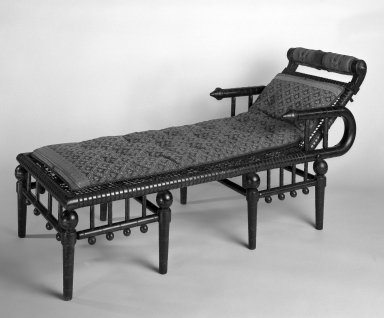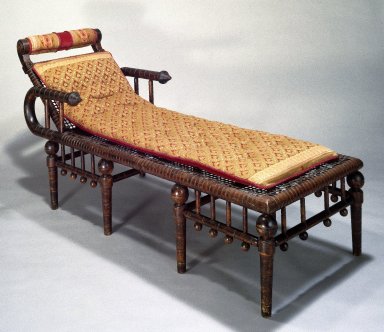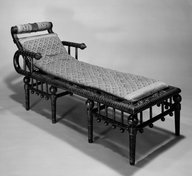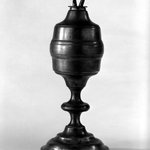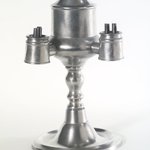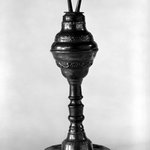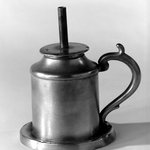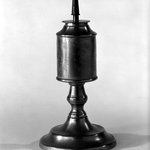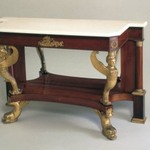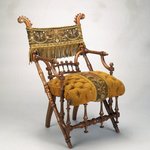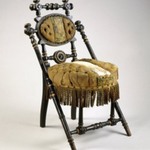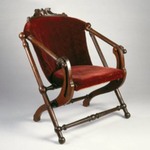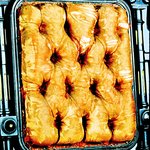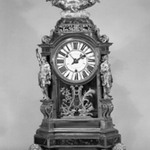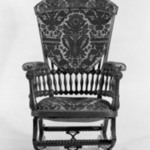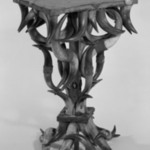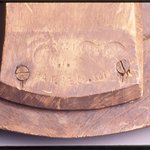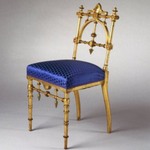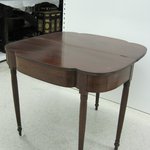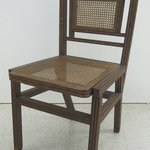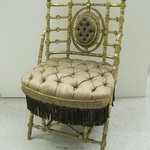Daybed
Decorative Arts and Design
MEDIUM
Maple and cloth-covered metal strips, late 19th century English textile applied to head rest and used to make cushion on bed.
DATES
Patented April 28, 1876
DIMENSIONS
31 x 25 x 66 in. (78.7 x 63.5 x 167.6 cm)
(show scale)
MARKINGS
On rear of back, proper right, near crest rail: "PAT. APRIL 18, 1876 / HUNZINGER"
SIGNATURE
no signature
INSCRIPTIONS
no inscriptions
ACCESSION NUMBER
86.177
CREDIT LINE
Gift of Bruce Newman
CATALOGUE DESCRIPTION
Daybed, maple and cloth-covered metal strips. Plain round seat rail with incised 3/8" indentations to accommodate metal strips which form woven seat and which were originally covered with red fabric. Each side seat rail forms U-shape near back and returns, parallel to seat, to form arms with cone-shaped turned terminals. Each arm supported by two turned spindles with incised lines. Incised lines here and throughout piece retain traces of original red paint. Seat sits on two rectangular stool-like elements, front and rear, each with four turned trumpet-and-ball legs; legs connected by stretchers and on sided and end of daybed, turned spindles connect seat rail and stretcher, with drop ball finial beneath each spindle. Back is rectangular frame of turned round members, woven metal strips between turned and circular bosses at upper junctures. Above is a padded headrest at crest, now in blue velvet. Back has moveable bar with E-shaped element attached which forms rear legs when daybed is fully reclined. Simple mechanism for adjusting back in U-shape of arms with separate plain bar (b) to hold up back. Now with a blue velvet cushion not to be accessioned. Late 19th century English textile applied to head rest and used to make cushion on bed in preparation for 1997 exhibtion.
CONDITION: General wear. Only traces of original red paint to be seen in incised lines. Woven seat is broken in central section; most fabric worn away; woven seat and back has been painted dark green and some traces of green paint can be seen on wooden frame, especially on back. Knob at proper right juncture of back and sea rail broken. Chips from edge of channel of adjustment mechanism, both sides.
MUSEUM LOCATION
This item is not on view
CAPTION
George Jakob Hunzinger (American, born Germany, 1835–1898). Daybed, Patented April 28, 1876. Maple and cloth-covered metal strips, late 19th century English textile applied to head rest and used to make cushion on bed., 31 x 25 x 66 in. (78.7 x 63.5 x 167.6 cm). Brooklyn Museum, Gift of Bruce Newman, 86.177. Creative Commons-BY (Photo: Brooklyn Museum, 86.177_view2_bw.jpg)
IMAGE
overall, 86.177_view2_bw.jpg. Brooklyn Museum photograph
"CUR" at the beginning of an image file name means that the image was created by a curatorial staff member. These study images may be digital point-and-shoot photographs, when we don\'t yet have high-quality studio photography, or they may be scans of older negatives, slides, or photographic prints, providing historical documentation of the object.
RIGHTS STATEMENT
Creative Commons-BY
You may download and use Brooklyn Museum images of this three-dimensional work in accordance with a
Creative Commons license. Fair use, as understood under the United States Copyright Act, may also apply.
Please include caption information from this page and credit the Brooklyn Museum. If you need a high resolution file, please fill out our online
application form (charges apply).
For further information about copyright, we recommend resources at the
United States Library of Congress,
Cornell University,
Copyright and Cultural Institutions: Guidelines for U.S. Libraries, Archives, and Museums, and
Copyright Watch.
For more information about the Museum's rights project, including how rights types are assigned, please see our
blog posts on copyright.
If you have any information regarding this work and rights to it, please contact
copyright@brooklynmuseum.org.
RECORD COMPLETENESS
Not every record you will find here is complete. More information is available for some works than for others, and some entries have been updated more recently. Records are frequently reviewed and revised, and
we welcome any additional information you might have.




